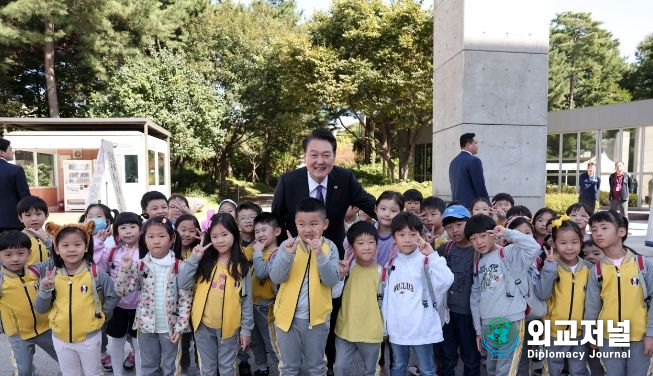By Lee Jon-young
President Yoon Suk-yeol made a surprise visit to the National Hangeul Museum on the morning of October 5, ahead of the 577th Hangeul Day (October 9). The National Hangeul Museum opened on October 9, 2014, to promote the literary and cultural values of Hangeul, the nation's greatest cultural heritage, and is holding various events this week from October 4 to celebrate the 2023 Hangeul Week with the theme of "The Power of Hangeul to Tap the Future.
In the front yard of the Hangeul Museum, children from Gwangmyeong City's Yebit Kindergarten and Hanam City's Myeongsung Daycare Center, who were wearing yellow uniforms and huddled like chicks listening to their teacher's explanations, gathered around the president to say 'hello' when he arrived.

The president asked the children how old they were and whether they had seen the museum, and took a commemorative photo with them. After the photo session, the children waved goodbye to the president as he walked toward the exhibition.
Once inside the museum, the president was guided by Yoo Ho-seon, the director of the Museum of Arts and Culture, through the permanent exhibition 'Hunmin Jeongeum, the Millennium Letter Plan'. As he walked through the exhibition rooms, which are divided into seven spaces, he viewed the Hunmin Jeongeum Haeryebon and Unhaebon, as well as the Jeongjo Hangeul Charts, a collection of 14 Hangeul letters that King Jeongjo sent to his maternal aunt when he was a child.
As the President and other visitors exclaimed in admiration at the scribbled like machine-printed text, Yoo explained that at the time, court ladies practiced Hangeul so hard that they would not be given lunch if they did not get it right.
In the next room, the president viewed the evolution of Hangeul in the modern era, including the manuscript of the first Korean language dictionary, Malmoi, modern Hangeul novels, the Daehan Daily Newspaper, and independent newspapers.
Yoo added that the use of Hangeul was legislated by an edict during the Gapo Reformation, which required laws and edicts to be written in Hangeul. The President then greeted the third-grade students from Ggummi School in Gangdong-gu, Seoul, who were viewing the digital materials in the digital exhibition room, saying that they had come because it was Hangeul Day, and encouraged them to continue to study Hangeul.
"The spirit of Hangeul, created by King Sejong the Great, is in line with the freedom, equality, and prosperity of our country today," the president said at the end of the tour. "King Sejong wanted everyone to be able to communicate freely through Hangeul, regardless of their status or gender," the president said, adding, "Contrary to the common misconception that it was only used by people of low status or women, Hangeul was actually used equally by people from all walks of life, from kings to servants."
Hangeul complaints by Mrs. Kim, the daughter of Manjung Kim, who wrote 'Jeongjo's Hangeul Language Book' and 'Guunmong,' to King Yeongjo, also show that Hangeul was used for free communication regardless of status and gender.
The President went on to mention data showing that various disputes were resolved in Hangul at government offices during the Joseon Dynasty, saying, "The use of Hangul in writing during the Joseon Dynasty means that Hangul was also widely used in government offices." He added, "The value of equality was realized when people who could not learn Hangul were able to appeal in Hangul, regardless of their status."
The President also emphasized that Hangeul has been the foundation of Korea's prosperity, saying, "The most advantageous characters in the digital age are the alphabet and Hangeul, and Hangeul has played a big role in helping us become an IT powerhouse." "During the Joseon Dynasty, we were able to be independent from Chinese characters because we had Hangeul," the president added.
After the tour, the President said goodbye to Kim Young-soo, the director of the National Hangeul Museum, and thanked the kindergarten and elementary school teachers who brought their students to celebrate Hangeul Day, saying, "It was a beneficial experience for me as well."







